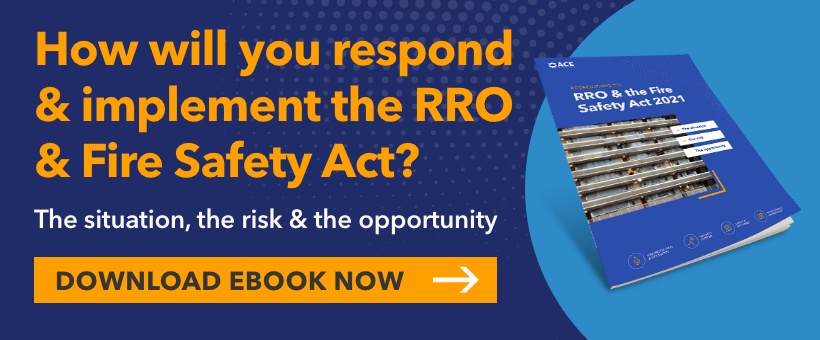Fire extinguishers play a crucial role in fire protection. They provide first aid fire-fighting capability, which can mean the difference between a small localised incident and one that presents a serious threat to people and property.
All workplaces are required to provide appropriate fire-fighting equipment, including fire-extinguishers, as stipulated by The Regulatory Reform (Fire Safety) Order 2005.
But to ensure you are adequately protected, you need to have the right types of fire extinguishers for your premises.
Classes of fire
There are different types of fire extinguishers designed to tackle six different ‘classes’ of fire:
- Class A (solids)
Class A fires are those involving solids such as paper, cardboard, wood, textiles or soft furnishings. These items are common in offices, making class A fires one of the most common types of fire.
- Class B (liquids)
- Class C (gases)
Class C fires are those involving gasses. Natural gas, LPG or other types of gas can form a flammable atmosphere.
- Class D (metals)
Class D fires are those involving combustible metals such as sodium, aluminium, lithium or magnesium. Metals are also good conductors which help a fire to spread.
- Electrical Fires
Technically, class E fires don’t exist, because electricity is a source of ignition rather than a fuel. Electrical fires, caused by electrical equipment such as computers, printers and photocopiers, can be extremely hazardous.
- Class F (cooking fats and oils)
Class F fires are those caused by the spillage of flammable oils or deep fat frying near to heat sources in kitchens.
Types of fire extinguishers
Each class of fire burns in different ways and they need different types of fire extinguishers to put them out.
There are five types:
- Water
Water fire extinguishers are the most common. They work by cooling the fire and usually have spray or jet nozzles. They are easy to maintain and the least hazardous.
Uses:Water fire extinguishers are most suitable for class A fires and should be present in offices, retail premises, schools, hotels, warehouses and multi-residence properties. They should be fitted next to exits in places that have been identified as class A fire risks during a fire risk assessment.
- Foam
Foam fire extinguishers work by smothering the fire and starving it of the oxygen it needs to burn.
Uses:
Foam fire extinguishers are the most common type of extinguisher used for class B fires, but as they are water-based, can also be used on class A fires. They should be fitted in all premises where flammable liquids are stored, such as offices, schools, hospitals, shops and multi-residence properties.
- Powder
Powder fire extinguishers (also known as ABC extinguishers) work by separating the fuel of the fire from the oxygen or by removing the heat element of the fire triangle.
Uses:
Powder fire extinguishers can be used on class A, B and C fires only (you need a special dry powder for Class D fires). They can also be used on electrical fires because they don’t contain water. However, the powder can get into equipment and cause damage. They should be stored in close proximity to the source of the fire risk.
- Carbon dioxide (CO2)
CO2 fire extinguishers work by replacing the oxygen in the air surrounding the fire so it doesn’t combust.
Uses:
It is best to use a CO2 fire extinguisher on electrical fires because they don’t contain water and won’t cause damage like powder extinguishers. They can also be used on class B fires, though are not as effective as foam or powder fire extinguishers.
- Wet Chemical
Wet chemical fire extinguishers work by making chemical changes to burning oils so they become non-combustible.
Uses:
Wet chemical fire extinguishers were designed specifically for class F fires and are mainly used in commercial kitchens. However, they can also be used on class A fires and some can be used on class B fires.
Which fire extinguishers do you need?
The types of fuel in your workplace will determine which types of fire extinguishers you need. Generally speaking, most commercial premises, as well as schools and healthcare facilities, require fire extinguishers to eliminate class A fires. The Regulatory Reform (Fire Safety) Order 2005 states that a minimum of two per floor are clearly accessible at all times.
A fire risk assessment will allow you to identify the specific types and number of fire extinguishers you require for your premises. The risk assessment will identify all the specific risks that exist in your building, look at what fire controls you already have in place, and then determine the type of equipment and fire extinguisher types needed to keep your people and property safe. The fire risk assessment should be reviewed regularly and changes made where necessary to prevent fire.
The importance of regular maintenance
Monthly inspections should be carried out to ensure fire extinguishers are where they are supposed to be, are easily accessible, have not been used or damaged, and are at the correct pressure. This can usually be carried out by a Facilities Manager or a member of your team.
Most fire extinguishers also require annual servicing by a competent engineer. This is to ensure they are fit for purpose and fully operational. Every 5-10 years they may also need a re-fill or replacement. Water, foam and powder fire extinguishers should be tested every 5 years. Carbon dioxide fire extinguishers should be tested every 10 years.
Many commercial businesses choose to work with one fire provider who can take care of all their fire needs, including installation and maintenance of not just fire extinguishers, but fire alarms, suppression systems and other fire protection systems. These companies can also carry out a fire risk assessment and advise you on the equipment you need. Having a one-stop-shop for all your fire protection needs will give you peace of mind that your people and property are safe.




 Previous Blog
Previous Blog

Comments.